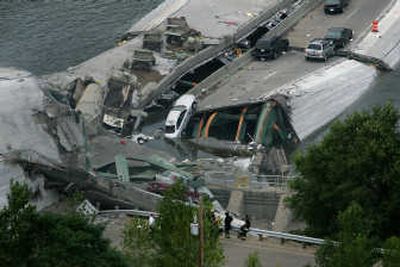Overstressed, underfunded

WASHINGTON – The bridge that lies crumpled in the Mississippi River is the latest link to fail in a national highway system rapidly deteriorating under the strain of ever-increasing traffic volume and inadequate upkeep, transportation experts said Thursday.
Once the sturdy pride of post-war America, the federal interstate system is now a vast network of aging roads and bridges, including many – such as the span that collapsed in Minneapolis – that engineers consider deficient or obsolete.
Despite record spending on highways, experts and engineers said federal funds aren’t enough to save the interstate system’s half-century-old bridges and 47,000 miles of highway from further decay, as a network designed to connect the nation teeters under a crush of commuter traffic.
“We’re falling further and further behind,” said Robert Poole, director of transportation studies at Reason Foundation and an adviser to the Federal Highway Administration. “We’re prospering as a nation, driving more as commuters and shipping more goods, and that’s pounding the highways and wearing them out.”
According to a 2005 Highway Administration report, more than 75,000 of the nation’s roughly 600,000 bridges – 13.1 percent – were rated “structurally deficient,” meaning some components of the bridges’ decks or support structures are rated poor or worse. While not necessarily unsafe, the structurally deficient designation often requires speed and weight restrictions to lessen the risk of collapse.
Concerns about bridge reliability pushed the state of the country’s infrastructure into the political arena Thursday, as Senate Majority Leader Harry Reid, D-Nev., called the Minneapolis bridge collapse a “wake-up call.”
“We have all over the country crumbling infrastructure – highways, bridges, dams – and we really need to take a hard look at this,” Reid said in a television interview.
Congress approved a six-year, $286 billion transportation funding package in 2005 that boosted highway and mass transit projects. But the government will need to spend $188 billion in the next 20 years just to fix the nation’s flawed bridges, according to a 2005 study by the American Society of Civil Engineers.
Though engineers have not yet determined why the Minneapolis bridge failed, bridge experts said its collapse was not necessarily the result of a physical breakdown.
Of the 1,502 recorded bridge failures between 1966 and 2005, nearly 60 percent were caused by soil erosion around the underwater bridge supports, according to Jean-Louis Briaud, a civil engineer with the Texas Transportation Institute.
“It’s the No. 1 killer of bridges,” he said. “If you create a hole around the bridge support, then the foundation cannot carry the load of the deck.”
Vigilant inspections can prevent failures, and the Minnesota collapse was particularly shocking to those who say safety has been improving.
“By and large, things are positive, and states have been spending more on bridges and making progress,” said Alan Pisarski, author of “Commuting in America,” who noted that the number of structurally deficient bridges in the country has declined in the past decade.
“But there are still a lot of them that are structurally deficient.”
Nevertheless, the overall national infrastructure is stuck in a “death spiral,” as states repeatedly fail to maintain the status quo condition of their transportation networks, Pisarski said. Maintenance standards slip further as the money is spread thin.
Diminishing tax revenues and surging costs have put a double squeeze on state transportation departments, transportation experts said.
While federal gas tax rates have remained at 18.4 cents a gallon since 1993, construction costs have been increasing 20 percent a year in some areas. The price of steel, oil and concrete are all up, partly driven by demand for raw materials in China, where the government is busy laying out a national highway system of its own.
Jerome Hajjar, professor of structural engineering at the University of Illinois Urbana at Champaign, said the American Society of Civil Engineers has been warning for years that the nation needs to devote more attention to its aging bridges.
“Each bridge is different, and each bridge needs to stand up,” he said. “Collapsing is not an option.”